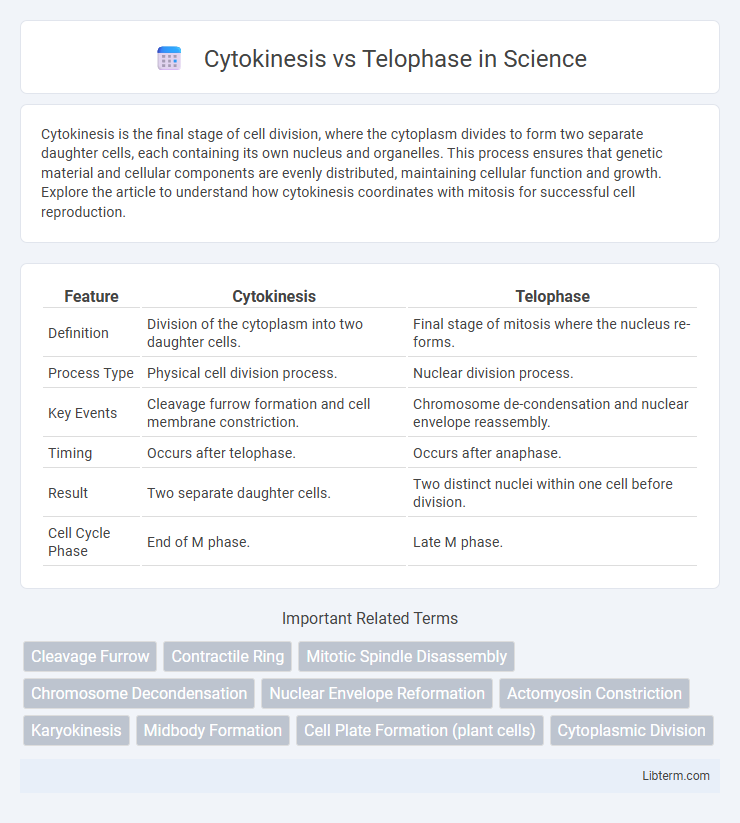Cytokinesis is the final stage of cell division, where the cytoplasm divides to form two separate daughter cells, each containing its own nucleus and organelles. This process ensures that genetic material and cellular components are evenly distributed, maintaining cellular function and growth. Explore the article to understand how cytokinesis coordinates with mitosis for successful cell reproduction.
Table of Comparison
| Feature | Cytokinesis | Telophase |
|---|---|---|
| Definition | Division of the cytoplasm into two daughter cells. | Final stage of mitosis where the nucleus re-forms. |
| Process Type | Physical cell division process. | Nuclear division process. |
| Key Events | Cleavage furrow formation and cell membrane constriction. | Chromosome de-condensation and nuclear envelope reassembly. |
| Timing | Occurs after telophase. | Occurs after anaphase. |
| Result | Two separate daughter cells. | Two distinct nuclei within one cell before division. |
| Cell Cycle Phase | End of M phase. | Late M phase. |
Introduction to Cell Division
Telophase is the final phase of mitosis where the chromosomes de-condense, nuclear envelopes re-form, and the cell prepares for division completion. Cytokinesis follows telophase, physically splitting the cytoplasm into two distinct daughter cells, ensuring each inherits organelles and cellular components. Together, telophase and cytokinesis finalize cell division, critical for growth, tissue repair, and reproduction in eukaryotic organisms.
Overview of Mitosis Stages
Telophase marks the final stage of mitosis where chromosomes decondense and nuclear envelopes re-form around each set of separated sister chromatids. Cytokinesis, often overlapping with telophase, completes cell division by physically splitting the cytoplasm into two distinct daughter cells. Together, these stages ensure accurate distribution of genetic material and cellular components after chromosome segregation during anaphase.
Defining Telophase: Key Processes
Telophase marks the final stage of mitosis where chromosomes arrive at opposite poles and begin to decondense into chromatin, while the nuclear envelope re-forms around each set. Key processes include spindle fiber disintegration and the reestablishment of nucleoli within the daughter nuclei. Cytokinesis, in contrast, occurs immediately after telophase, dividing the cytoplasm to produce two separate daughter cells, completing cell division.
What is Cytokinesis?
Cytokinesis is the process during cell division where the cytoplasm divides, resulting in two distinct daughter cells. It typically occurs immediately after telophase, which is the stage when the chromosomes reach the poles and begin to decondense. Cytokinesis ensures proper cell membrane formation and organelle distribution, completing the physical separation of the daughter cells.
Sequence: Telophase Before Cytokinesis
Telophase marks the final stage of mitosis where nuclear envelopes re-form around the separated chromosomes, which begin to decondense. Cytokinesis follows telophase, completing the cell division by physically splitting the cytoplasm and creating two distinct daughter cells. This sequence ensures that genetic material is securely enclosed in nuclei before the cell divides its cytoplasmic contents.
Structural Changes in Telophase
Telophase is marked by the reformation of the nuclear envelope around each set of separated chromatids, transitioning chromosomes from a condensed to a more relaxed chromatin state. Concurrently, the mitotic spindle fibers disassemble, and nucleoli reappear, signaling the end of chromosome segregation. In contrast, cytokinesis involves the physical division of the cytoplasm through the formation of a contractile ring, ultimately producing two distinct daughter cells.
Mechanisms of Cytokinesis
Cytokinesis involves the physical division of the cytoplasm through the formation of a contractile ring composed of actin and myosin filaments, which constricts to form a cleavage furrow that eventually separates the two daughter cells. This process contrasts with telophase, where nuclear envelope reformation and chromatin decondensation occur, marking the end of mitosis but not the actual cytoplasmic division. Key regulatory proteins such as RhoA GTPase orchestrate the assembly and contraction of the actomyosin ring, ensuring precise cytokinesis completion following telophase.
Differences Between Telophase and Cytokinesis
Telophase is the stage of mitosis where nuclear membranes re-form around the separated chromosomes, leading to the formation of two distinct nuclei, whereas cytokinesis is the process that physically divides the cytoplasm and cell membrane to create two separate daughter cells. Telophase involves chromosomal decondensation and the reestablishment of the nucleolus, while cytokinesis completes cell division through the formation of a cleavage furrow in animal cells or a cell plate in plant cells. The key difference lies in telophase finalizing nuclear division, whereas cytokinesis completes the entire cellular division.
Biological Significance in Cell Reproduction
Telophase finalizes mitosis by re-establishing the nuclear envelope around the separated chromosomes, ensuring accurate genetic material partitioning. Cytokinesis completes cell division by physically separating the cytoplasm, resulting in two distinct daughter cells capable of independent function. Together, these processes ensure faithful cell reproduction and maintain genetic stability across generations.
Summary: Telophase vs. Cytokinesis
Telophase marks the final stage of mitosis where chromosomes decondense, nuclear envelopes reform, and the spindle apparatus disassembles, preparing the cell for division completion. Cytokinesis follows telophase, involving the physical separation of the cytoplasm into two distinct daughter cells through the formation of a cleavage furrow in animal cells or a cell plate in plant cells. While telophase concludes nuclear division, cytokinesis finalizes the overall cell division process, ensuring each daughter cell receives proper cellular components.
Cytokinesis Infographic

 libterm.com
libterm.com